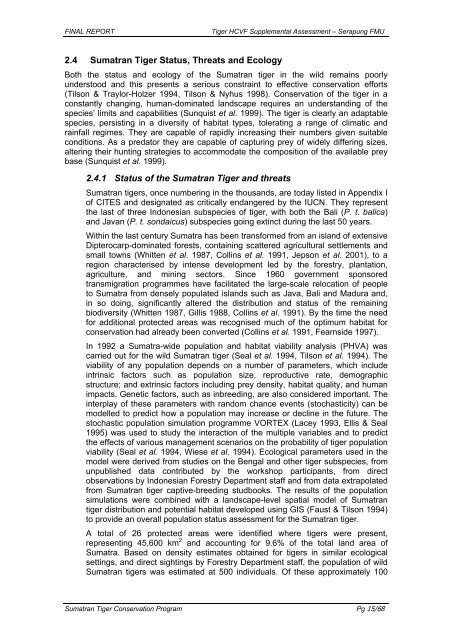A Supplemental HCVF Assessment on the Sumatran Tiger ...
A Supplemental HCVF Assessment on the Sumatran Tiger ...
A Supplemental HCVF Assessment on the Sumatran Tiger ...
Create successful ePaper yourself
Turn your PDF publications into a flip-book with our unique Google optimized e-Paper software.
FINAL REPORT <strong>Tiger</strong> <str<strong>on</strong>g>HCVF</str<strong>on</strong>g> <str<strong>on</strong>g>Supplemental</str<strong>on</strong>g> <str<strong>on</strong>g>Assessment</str<strong>on</strong>g> – Serapung FMU<br />
2.4 <strong>Sumatran</strong> <strong>Tiger</strong> Status, Threats and Ecology<br />
Both <strong>the</strong> status and ecology of <strong>the</strong> <strong>Sumatran</strong> tiger in <strong>the</strong> wild remains poorly<br />
understood and this presents a serious c<strong>on</strong>straint to effective c<strong>on</strong>servati<strong>on</strong> efforts<br />
(Tils<strong>on</strong> & Traylor-Holzer 1994, Tils<strong>on</strong> & Nyhus 1998). C<strong>on</strong>servati<strong>on</strong> of <strong>the</strong> tiger in a<br />
c<strong>on</strong>stantly changing, human-dominated landscape requires an understanding of <strong>the</strong><br />
species’ limits and capabilities (Sunquist et al. 1999). The tiger is clearly an adaptable<br />
species, persisting in a diversity of habitat types, tolerating a range of climatic and<br />
rainfall regimes. They are capable of rapidly increasing <strong>the</strong>ir numbers given suitable<br />
c<strong>on</strong>diti<strong>on</strong>s. As a predator <strong>the</strong>y are capable of capturing prey of widely differing sizes,<br />
altering <strong>the</strong>ir hunting strategies to accommodate <strong>the</strong> compositi<strong>on</strong> of <strong>the</strong> available prey<br />
base (Sunquist et al. 1999).<br />
2.4.1 Status of <strong>the</strong> <strong>Sumatran</strong> <strong>Tiger</strong> and threats<br />
<strong>Sumatran</strong> tigers, <strong>on</strong>ce numbering in <strong>the</strong> thousands, are today listed in Appendix I<br />
of CITES and designated as critically endangered by <strong>the</strong> IUCN. They represent<br />
<strong>the</strong> last of three Ind<strong>on</strong>esian subspecies of tiger, with both <strong>the</strong> Bali (P. t. balica)<br />
and Javan (P. t. s<strong>on</strong>daicus) subspecies going extinct during <strong>the</strong> last 50 years.<br />
Within <strong>the</strong> last century Sumatra has been transformed from an island of extensive<br />
Dipterocarp-dominated forests, c<strong>on</strong>taining scattered agricultural settlements and<br />
small towns (Whitten et al. 1987, Collins et al. 1991, Jeps<strong>on</strong> et al. 2001), to a<br />
regi<strong>on</strong> characterised by intense development led by <strong>the</strong> forestry, plantati<strong>on</strong>,<br />
agriculture, and mining sectors. Since 1960 government sp<strong>on</strong>sored<br />
transmigrati<strong>on</strong> programmes have facilitated <strong>the</strong> large-scale relocati<strong>on</strong> of people<br />
to Sumatra from densely populated islands such as Java, Bali and Madura and,<br />
in so doing, significantly altered <strong>the</strong> distributi<strong>on</strong> and status of <strong>the</strong> remaining<br />
biodiversity (Whitten 1987, Gillis 1988, Collins et al. 1991). By <strong>the</strong> time <strong>the</strong> need<br />
for additi<strong>on</strong>al protected areas was recognised much of <strong>the</strong> optimum habitat for<br />
c<strong>on</strong>servati<strong>on</strong> had already been c<strong>on</strong>verted (Collins et al. 1991, Fearnside 1997).<br />
In 1992 a Sumatra-wide populati<strong>on</strong> and habitat viability analysis (PHVA) was<br />
carried out for <strong>the</strong> wild <strong>Sumatran</strong> tiger (Seal et al. 1994, Tils<strong>on</strong> et al. 1994). The<br />
viability of any populati<strong>on</strong> depends <strong>on</strong> a number of parameters, which include<br />
intrinsic factors such as populati<strong>on</strong> size, reproductive rate, demographic<br />
structure; and extrinsic factors including prey density, habitat quality, and human<br />
impacts. Genetic factors, such as inbreeding, are also c<strong>on</strong>sidered important. The<br />
interplay of <strong>the</strong>se parameters with random chance events (stochasticity) can be<br />
modelled to predict how a populati<strong>on</strong> may increase or decline in <strong>the</strong> future. The<br />
stochastic populati<strong>on</strong> simulati<strong>on</strong> programme VORTEX (Lacey 1993, Ellis & Seal<br />
1995) was used to study <strong>the</strong> interacti<strong>on</strong> of <strong>the</strong> multiple variables and to predict<br />
<strong>the</strong> effects of various management scenarios <strong>on</strong> <strong>the</strong> probability of tiger populati<strong>on</strong><br />
viability (Seal et al. 1994, Wiese et al. 1994). Ecological parameters used in <strong>the</strong><br />
model were derived from studies <strong>on</strong> <strong>the</strong> Bengal and o<strong>the</strong>r tiger subspecies, from<br />
unpublished data c<strong>on</strong>tributed by <strong>the</strong> workshop participants, from direct<br />
observati<strong>on</strong>s by Ind<strong>on</strong>esian Forestry Department staff and from data extrapolated<br />
from <strong>Sumatran</strong> tiger captive-breeding studbooks. The results of <strong>the</strong> populati<strong>on</strong><br />
simulati<strong>on</strong>s were combined with a landscape-level spatial model of <strong>Sumatran</strong><br />
tiger distributi<strong>on</strong> and potential habitat developed using GIS (Faust & Tils<strong>on</strong> 1994)<br />
to provide an overall populati<strong>on</strong> status assessment for <strong>the</strong> <strong>Sumatran</strong> tiger.<br />
A total of 26 protected areas were identified where tigers were present,<br />
representing 45,600 km 2 and accounting for 9.6% of <strong>the</strong> total land area of<br />
Sumatra. Based <strong>on</strong> density estimates obtained for tigers in similar ecological<br />
settings, and direct sightings by Forestry Department staff, <strong>the</strong> populati<strong>on</strong> of wild<br />
<strong>Sumatran</strong> tigers was estimated at 500 individuals. Of <strong>the</strong>se approximately 100<br />
<strong>Sumatran</strong> <strong>Tiger</strong> C<strong>on</strong>servati<strong>on</strong> Program Pg 15/68

















